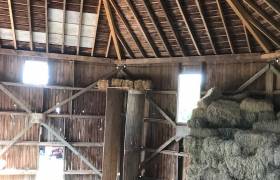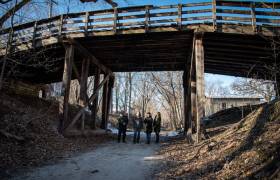Cruise on over to this celebration of of...
McHenry County tourism initiative rooted in history
A rare, octagonal horse barn in Spring Grove may live on as an event venue.
Brothers George and Robert Richardson, together with their wives and children, want to disassemble and relocate the former Hatch barn to their Richardson Adventure Farm, at 909 English Prairie Road in Spring Grove. The first tower silo in America was erected in 1873 by Fred L. Hatch and his father, Lewis. Just remnants of its foundation remain. But the property, located at 801 Main St., does include a beautiful 1959 rainbow-truss barn and the aforementioned 50-foot-diameter, eight-sided barn.
“We love history and we love playing up history on our farm,” George Richardson told the McHenry County Historic Preservation Commission this month. Since 1836, the family farm has gravitated from corn and soybeans, to hogs, to Christmas trees. They planted 14,000 seedlings in 1981; and then added a corn maze in 2001 and tulips in 2021.
The business provides close to 180 seasonal jobs and attract about 40,000 visitors a year.
The Richardsons want to convert the unique barn into a destination space, accommodating between 100 and 299 people – avoiding the headaches of sprinkling a vintage building. New wings attached to the main hall will accommodate a kitchen for catering and restrooms. The existing loft will be removed in order to add to the cathedral-like feel.
George Richardson said the family already invested $40,000 toward what is ultimately estimated to cost $1 million. They hoped to begin disassembling the barn – including the trusses, posts and tongue-and-groove siding – by now. But the county commission’s wish to preserve the structures on their original site put a kink the in the process with property owner/developer Jack Pease, and also sparked a flurry of negotiations with county board members.
The Richardsons hope to open the reconstituted barn by next June. However, they anticipate it will take a month to properly remove, mark and transport all the pieces by flatbed trailer to the new site and assemble them on the new foundation. And the fall/winter season gets especially busy. Compromise and collaboration are key, if this piece of history is to be saved.
“We saw the potential of something larger but on a different site,” George Richardson said. “This [moving it] is the next best thing.”
•••
Two Crystal Lake residents were among eight people who died May 1 in a downstate dust storm that injured nearly 40 others and left Interstate 55 littered with vehicles.
“Incidents like these are a tragic consequence of the shortsighted practices demanded by the monopoly corporations that control our agriculture system,” Farm Action said in a written statement. “Industrial practices which limit crop rotation in favor of monocropping and heavy herbicide application have resulted in unprecedented soil erosion and severe weather events – which cost us not only our agricultural system’s resilience but human life itself.”
Shortly before 11 a.m., winds whipped dust from newly plowed fields into a cyclonic veil that extinguished visibility throughout areas of Sangamon and Montgomery counties. It brings to mind the Dust Bowl era of the 1930s – a term coined by Associated Press reporter Robert Geiger to describe the drought-ridden Great Plains. Studies estimate that some 1.2 billion tons of soil were lost across 100 million acres in 1934-35, the drought’s most severe period.
“Since most of the best farming areas were already being used, poorer farmlands were increasingly used. Farming submarginal lands often had negative results, such as soil erosion and nutrient leaching.,” the National Drought Mitigation Center said of the period. “Basically, reductions in soil conservation measures and the encroachment onto poorer lands made the farming community more vulnerable to wind erosion, soil moisture depletion, depleted soil nutrients, and drought.”
A December 2020 study by the Union of Concerned Scientists said unhealthy farming practices and climate extremes could cost U.S. farmers a half-inch of topsoil by 2035 – more than eight times the amount of topsoil lost during the Dust Bowl. I thought of that as I drove through dust clouds kicked up by earlier this month.
Little wonder the state Senate approved and sent to the governor the “Illinois Healthy Soils and Watersheds Initiative” during the spring legislative session. Senate Bill 1701 seeks to reduce nutrient loss, improve soil and water quality, protect drinking water, increase the resilience of ecosystems to extreme weather events, protect and improve agricultural productivity, and support aquatic and wildlife habitat.
Spring Duffy, executive director of the McHenry-Lake County Soil and Water Conservation District, said minimal tilling of fields, in which new crops are planted in the residue left from the last harvest, and the use of cover crops – such as cereal rye and winter wheat – prevent erosion, add organic matter to the soil and suppress weeds. Subsidies offered through the Illinois Cover Crop Initiative range from $5 to $16 an acre.
“A lot of farmers do this because financially it makes good sense,” Duffy said, “and they want to be good stewards of the land.”
•••
Join the McHenry County Historical Society for its 60th anniversary museum opening event from 5 to 8 p.m. Friday, June 2, at the museum, 6422 Main St., Union. Enjoy free access to the museum and a number of new exhibits, live music by Johnny and the Madmen, great food from Kissed By Fire and Milk House Ice Cream, and samples from the county’s own local craft breweries.
• Kurt Begalka, former administrator of the McHenry County Historical Society and Museum.
Published May 29, 2023, in the Northwest Herald
 © 2025 MCHS- All Rights Reserved.
© 2025 MCHS- All Rights Reserved.















